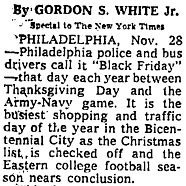Marketing History Series: The Dark Origins & Reinvention of Black Friday
In the United States, Black Friday marks the busiest shopping day of the year. Right now an estimated 74 million Americans are planning on dropping a lot of money the day after Thanksgiving, taking advantage of major annual deals to save big on holiday shopping, stock up on goods & essentials, and buy high-value wishlist items.
Although millions of people are actively participating in this huge shopping event, few people know its origins or how the term “Black Friday” in regards to retail was conceived. Read on to learn about the crazy, dark and violent origins of the biggest sale of the year.
The Black & The Gold
One of the first uses of the actual term “Black Friday,” wasn’t associated with post-Thanksgiving shopping, but instead with a major financial crisis: the U.S. gold market crash of Friday, September 24, 1869. The crash left thousands bankrupt, and was the sole result of the vicious scheming of two Wall Street financiers, Jim Fisk and Jay Gould. Fisk and Gould conspired together to buy up as much gold as they could, in the attempt to astronomically drive up the price of gold, and then sell it back at an abominable profit. This led to a major stock market crash, leaving everyone from millionaires to blue-collar workers completely destitute. That horrible day in history came to be known as Black Friday.
Black Friday & Retail
The origin of how Black Friday came to be associated with the day after Thanksgiving can be traced back to the late 19th and early 20th century. Thanksgiving Day parades were often sponsored by big department stores (Macy’s first Thanksgiving day Parade was in 1924). Often, the last floats in these processions would involve Santa Claus. This marked the unofficial and some might say subliminal start to the holiday shopping season.
Early on, major retailers were eager to find ways to optimize the profits they received from the day after Thanksgiving sales. In 1939, they even petitioned the government, pleading with them to move up Thanksgiving Day to avoid retail sales plummeting . Franklin D. Roosevelt obliged, and moved the holiday from the fourth Thursday of November to the third. This was an utter disaster, as many Americans objected to the capitalistic change to tradition. They mockingly dubbed it “Franksgiving,” and many continued to celebrate it on the original day. In 1941, congress officially moved Thanksgiving back to the last Thursday of November.
The first recorded time “Black Friday” was used in a retail sense was in Philadelphia in the mid 1960s. The day after Thanksgiving, the City of Brotherly Love would receive an influx of tourists to enjoy a day of bargain shopping, and sports fans to watch the annual Army-Navy football game that took place the following Saturday. While great for retailers, this represented a logistical nightmare for Philadelphia law enforcement. Instead of enjoying a day off like many Americans, policemen, firemen and transportation services had to work overtime. Thus earning the name “Black Friday” by Philadelphia's finest.
As the term “Black Friday'' became widespread, store owners didn’t want their biggest sales day associated with any negativity. In the 1980s, a marketing push claimed Black Friday’s origins were traced to simple accounting. When retailers used to record their profits and losses in their accounting books, losses would be marked as red, while profits would be indicated in black. The story maintains that after a year of operating at a loss, “in the red,” the post- Thanksgiving day discounts skyrocketed sales and brought retailers “back in black.”
A Dark Past, A Brighter Future?
Black Friday has a reputation for big savings, but it also has a reputation for chaos and greed, a combination that not very long ago had deadly consequences. In 2008, over two-thousand Walmart customers waited in line since Thanksgiving evening to score on Black Friday deals. When the doors opened in the morning, a stampede pushed through and trampled a 34-year-old employee to death. Although absolutely horrific, we are hopeful this is a situation that is unlikely to repeat itself.
Since the mid 2010s, Black Friday savings have increasingly been available through online shopping. Everyone from small ecommerce brands to major US retailers are giving customers the option to skip the lines and the pandemonium to cash in on major discounts from the comfort of their own homes. Now, as we’re still in the midst of a pandemic, online Black Friday deals have become sine qua non.
Last year, online Black Friday sales went up 21%, representing $9B in spending. This year, online spending is anticipated to increase another 20%. In a 2021 survey, 60% of participants cited “crowds” as the top reason for avoiding in-store shopping. The second most common concern was health and safety.
Now, it’s more important than ever for brands to have a digital strategy in place to secure their fair share of online Black Friday spending. The market is getting increasingly saturated, and competing with hundreds of “not-to-miss” promotions can be overwhelming. If you need help making sure you’re set up for success this Black Friday, take a look at our 2021 Black Friday Checklist.
We wish everyone a wonderful Thanksgiving and have a fun (& safe) Black Friday!







